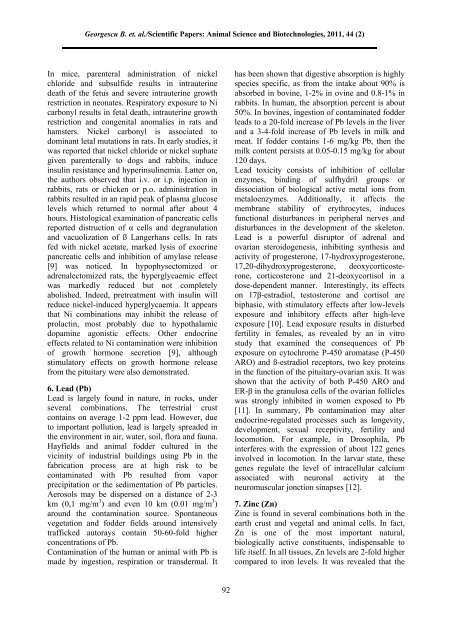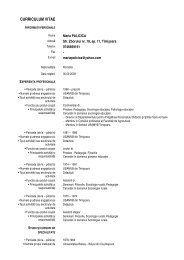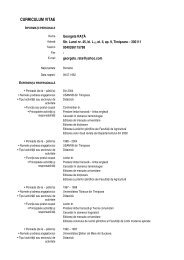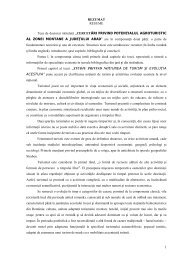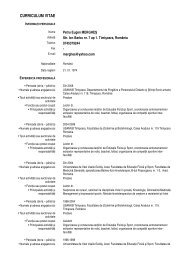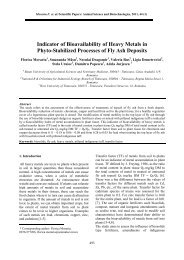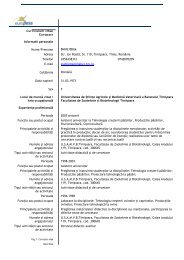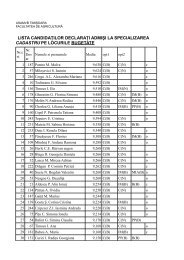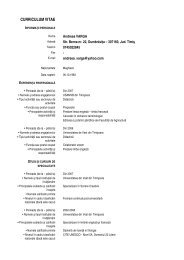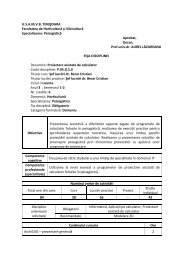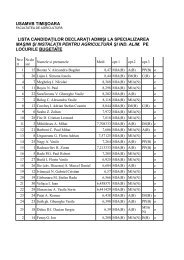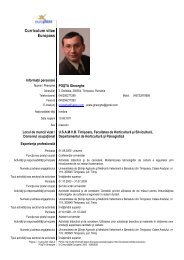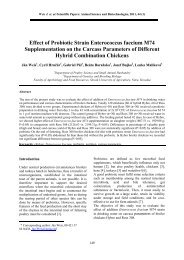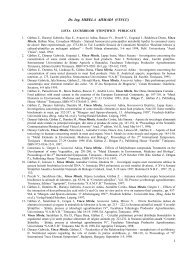Heavy Metals Acting as Endocrine Disrupters
Heavy Metals Acting as Endocrine Disrupters
Heavy Metals Acting as Endocrine Disrupters
You also want an ePaper? Increase the reach of your titles
YUMPU automatically turns print PDFs into web optimized ePapers that Google loves.
Georgescu B. et. al./Scientific Papers: Animal Science and Biotechnologies, 2011, 44 (2)In mice, parenteral administration of nickelchloride and subsulfide results in intrauterinedeath of the fetus and severe intrauterine growthrestriction in neonates. Respiratory exposure to Nicarbonyl results in fetal death, intrauterine growthrestriction and congenital anomalies in rats andhamsters. Nickel carbonyl is <strong>as</strong>sociated todominant letal mutations in rats. In early studies, itw<strong>as</strong> reported that nickel chloride or nickel suphategiven parenterally to dogs and rabbits, induceinsulin resistance and hyperinsulinemia. Latter on,the authors observed that i.v. or i.p. injection inrabbits, rats or chicken or p.o. administration inrabbits resulted in an rapid peak of pl<strong>as</strong>ma glucoselevels which returned to normal after about 4hours. Histological examination of pancreatic cellsreported distruction of α cells and degranulationand vacuolization of ß Langerhans cells. In ratsfed with nickel acetate, marked lysis of exocrinepancreatic cells and inhibition of amyl<strong>as</strong>e rele<strong>as</strong>e[9] w<strong>as</strong> noticed. In hypophysectomized oradrenalectomized rats, the hyperglycaemic effectw<strong>as</strong> markedly reduced but not completelyabolished. Indeed, pretreatment with insulin willreduce nickel-induced hyperglycaemia. It appearsthat Ni combinations may inhibit the rele<strong>as</strong>e ofprolactin, most probably due to hypothalamicdopamine agonistic effects. Other endocrineeffects related to Ni contamination were inhibitionof growth hormone secretion [9], althoughstimulatory effects on growth hormone rele<strong>as</strong>efrom the pituitary were also demonstrated.6. Lead (Pb)Lead is largely found in nature, in rocks, underseveral combinations. The terrestrial crustcontains on average 1-2 ppm lead. However, dueto important pollution, lead is largely spreaded inthe environment in air, water, soil, flora and fauna.Hayfields and animal fodder cultured in thevicinity of industrial buildings using Pb in thefabrication process are at high risk to becontaminated with Pb resulted from vaporprecipitation or the sedimentation of Pb particles.Aerosols may be dispersed on a distance of 2-3km (0,1 mg/m 3 ) and even 10 km (0.01 mg/m 3 )around the contamination source. Spontaneousvegetation and fodder fields around intensivelytrafficked autorays contain 50-60-fold higherconcentrations of Pb.Contamination of the human or animal with Pb ismade by ingestion, respiration or transdermal. Ith<strong>as</strong> been shown that digestive absorption is highlyspecies specific, <strong>as</strong> from the intake about 90% isabsorbed in bovine, 1-2% in ovine and 0.8-1% inrabbits. In human, the absorption percent is about50%. In bovines, ingestion of contaminated fodderleads to a 20-fold incre<strong>as</strong>e of Pb levels in the liverand a 3-4-fold incre<strong>as</strong>e of Pb levels in milk andmeat. If fodder contains 1-6 mg/kg Pb, then themilk content persists at 0.05-0.15 mg/kg for about120 days.Lead toxicity consists of inhibition of cellularenzymes, binding of sulfhydril groups ordissociation of biological active metal ions frommetaloenzymes. Additionally, it affects themembrane stability of erythrocytes, inducesfunctional disturbances in peripheral nerves anddisturbances in the development of the skeleton.Lead is a powerful disruptor of adrenal andovarian steroidogenesis, inhibiting synthesis andactivity of progesterone, 17-hydroxyprogesterone,17,20-dihydroxyprogesterone, deoxycorticosterone,corticosterone and 21-deoxycortisol in adose-dependent manner. Interestingly, its effectson 17β-estradiol, testosterone and cortisol arebiph<strong>as</strong>ic, with stimulatory effects after low-levelsexposure and inhibitory effects after high-leveexposure [10]. Lead exposure results in disturbedfertility in females, <strong>as</strong> revealed by an in vitrostudy that examined the consequences of Pbexposure on cytochrome P-450 aromat<strong>as</strong>e (P-450ARO) and ß-estradiol receptors, two key proteinsin the function of the pituitary-ovarian axis. It w<strong>as</strong>shown that the activity of both P-450 ARO andER-β in the granulosa cells of the ovarian folliclesw<strong>as</strong> strongly inhibited in women exposed to Pb[11]. In summary, Pb contamination may alterendocrine-regulated processes such <strong>as</strong> longevity,development, sexual receptivity, fertility andlocomotion. For example, in Drosophila, Pbinterferes with the expression of about 122 genesinvolved in locomotion. In the larvar state, thesegenes regulate the level of intracellular calcium<strong>as</strong>sociated with neuronal activity at theneuromuscular jonction sinapses [12].7. Zinc (Zn)Zinc is found in several combinations both in theearth crust and vegetal and animal cells. In fact,Zn is one of the most important natural,biologically active constituents, indispensable tolife itself. In all tissues, Zn levels are 2-fold highercompared to iron levels. It w<strong>as</strong> revealed that the92


